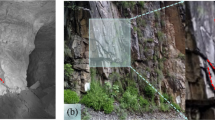Abstract
The common information about the average porosity of a given porous material (like sintered powder materials) may not be sufficient for design purposes. It is evident that an occasional localization of pores (‘damage’) may trigger premature failure at a low global average porosity. In order to avoid this limitation we suggest here two measuring techniques to assess the spatial distribution of the damage in one and two dimensions. (1) Macro-measurement: The idea is based on removing (in consecutive steps) thin layers from the outer boundary of the workpiece and measuring the density and weight of the residual workpiece between each step. The repeated cycles of ‘cutting and measuring’ give the distribution of the pores in the cross section of the workpiece (averaged across the height of the section). (2) Micro-measurement: Magnified pictures are taken from selected metallographic sections of the workpiece. An area scanner is employed to measure the ‘local porosity’ by providing the ratio between the dark areas to the total area occupied by each picture. This procedure renders directly the 2D distribution of the pores in a given cross section. Porous specimens made by powder metallurgy (Fe and 304 stainless steel) are compressed unidirectionally. The evolution of the porosity due to the compacting process is measured by these two techniques. The measurements show how the initial pore distribution evolves in space and time during the compression process. The results are compared to a semi-analytical simulation of the densification process using the limit analysis formulations.
Similar content being viewed by others
References
ASTM Standard B311–86. Standard Test Method For Density Of Cemented Carbides.
Becker, R. (1987). The effect of porosity distribution on ductile failure. Journal of the Mechanics and Physics of Solids 35, 577–599.
Gurson, A.L. (1977). Continuum theory of ductile rapture by void nucleation and growth: part I — Yield criteria and flow rules for porous ductile media. Transactions of ASME, Journal of Materials and Technology 99, 2–15.
Haghi, M. and Anand, L. (1993). A constitutive model for isotropic, porous, elastic-viscoplastic metals. Mechanics of Materials 3, 37–53.
Moon, J.H. and Yang, D.Y. (1992). A method of measurement for determination of relative density in axisymmetric forming of sintered porous material. Journal of Materials Processing Technology 33, 311–318.
Schneider, G., Postler, I. and Wuhrl, I. (1996). Quantitative structure analysis with sintered materials. Structure 29, 19–23.
Shirizly, A., Tirosh, J. and Rubinski, L. (1996). On the Densification Process of Porous Materials Under Uniaxial Compression: Theory and Experiments. Submitted.
Spitzig, W.A., Kelly, J.F. and Richmond, O. (1985). Quantitative characterization of second-phase populations. Metallography 18, 235–261.
Spitzig, W.E., Smelser, R.E. and Richmond, O. (1988). The evolution of damage and fracture in iron compacts with various initial porosities. Acta Metallurgica 36, 1201–1211.
Tirosh, J. and Iddan, D. (1989). Forming analysis of porous materials. International Journal of Mechanical Science 31, 945–965.
Tvergaard, V. (1981). Influence of voids on shear band instabilities under plane strain conditions. International Journal of Fracture 17, 389–407.
Tvergaard, V. (1982). On localization in ductile materials containing spherical voids. International Journal of Fracture 18, 237–251.
Wang, P.T. and Karabin, M.E. (1990). Evolution of porosity during thin plate rolling of porous metals. Microstructural Evolution in Metal Processing, ASME PED 46, 47–58.
Wang, P.T. and Richmond, O. (1992). Overview of a two state variable constitutive model for the consolidation and forming processes of powder-based porous metals. Mechanics of Granular Materials and Powder Systems, ASME MD 37, 63–81.
Wray, P.J., Richmond, O. and Morrison, H.L. (1983). Use of the Dirichlet tessellation for characterizing and modeling nonregular dispersions of second-phase particles. Metallography 16, 39–58.
Author information
Authors and Affiliations
Rights and permissions
About this article
Cite this article
Shirizyl, A., Rittel, D., Rubinski, L. et al. On damage distribution in the upsetting process of sintered porous materials. International Journal of Fracture 97, 321–336 (1999). https://doi.org/10.1023/A:1018332431030
Issue Date:
DOI: https://doi.org/10.1023/A:1018332431030




